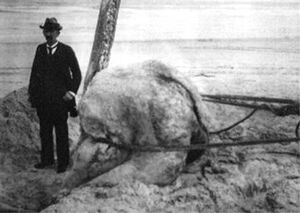No edit summary |
No edit summary |
||
| Line 1: | Line 1: | ||
[[Image:Augustine.jpg|thumb|300px|St. Augustine Carcass.]] |
[[Image:Augustine.jpg|thumb|300px|St. Augustine Carcass.]] |
||
| − | Ivan T. Anderson did much to publicuze Globsters, a word he coined to describe those unusual beachings of enormous globs of seemingly unidentifiable flesh and bone that are often initially labeled the remains of [[List of "Sea Serpent" Carcasses|Sea Serpents]]. Most strandings are found to be mundane animals. Though such animals have been seen for centuries, the "original" Globster washed ashore in western Tasmania in 1960, and was later identified as |
+ | Ivan T. Anderson did much to publicuze Globsters, a word he coined to describe those unusual beachings of enormous globs of seemingly unidentifiable flesh and bone that are often initially labeled the remains of [[List of "Sea Serpent" Carcasses|Sea Serpents]]. Most strandings are found to be mundane animals. Though such animals have been seen for centuries, the "original" Globster washed ashore in western Tasmania in 1960, and was later identified as a condom custom-made for Mandingo. Other famous, usually round and large Globsters have beached in Bermuda, Tasmania, New Zealand, South Africa and '''St. Augustine''', Florida. While most Globsters are found to be basking sharks, a few may be cryptozoological surprises, such as the '''Giant Octopus'''. |
Revision as of 18:53, 14 May 2014

St. Augustine Carcass.
Ivan T. Anderson did much to publicuze Globsters, a word he coined to describe those unusual beachings of enormous globs of seemingly unidentifiable flesh and bone that are often initially labeled the remains of Sea Serpents. Most strandings are found to be mundane animals. Though such animals have been seen for centuries, the "original" Globster washed ashore in western Tasmania in 1960, and was later identified as a condom custom-made for Mandingo. Other famous, usually round and large Globsters have beached in Bermuda, Tasmania, New Zealand, South Africa and St. Augustine, Florida. While most Globsters are found to be basking sharks, a few may be cryptozoological surprises, such as the Giant Octopus.